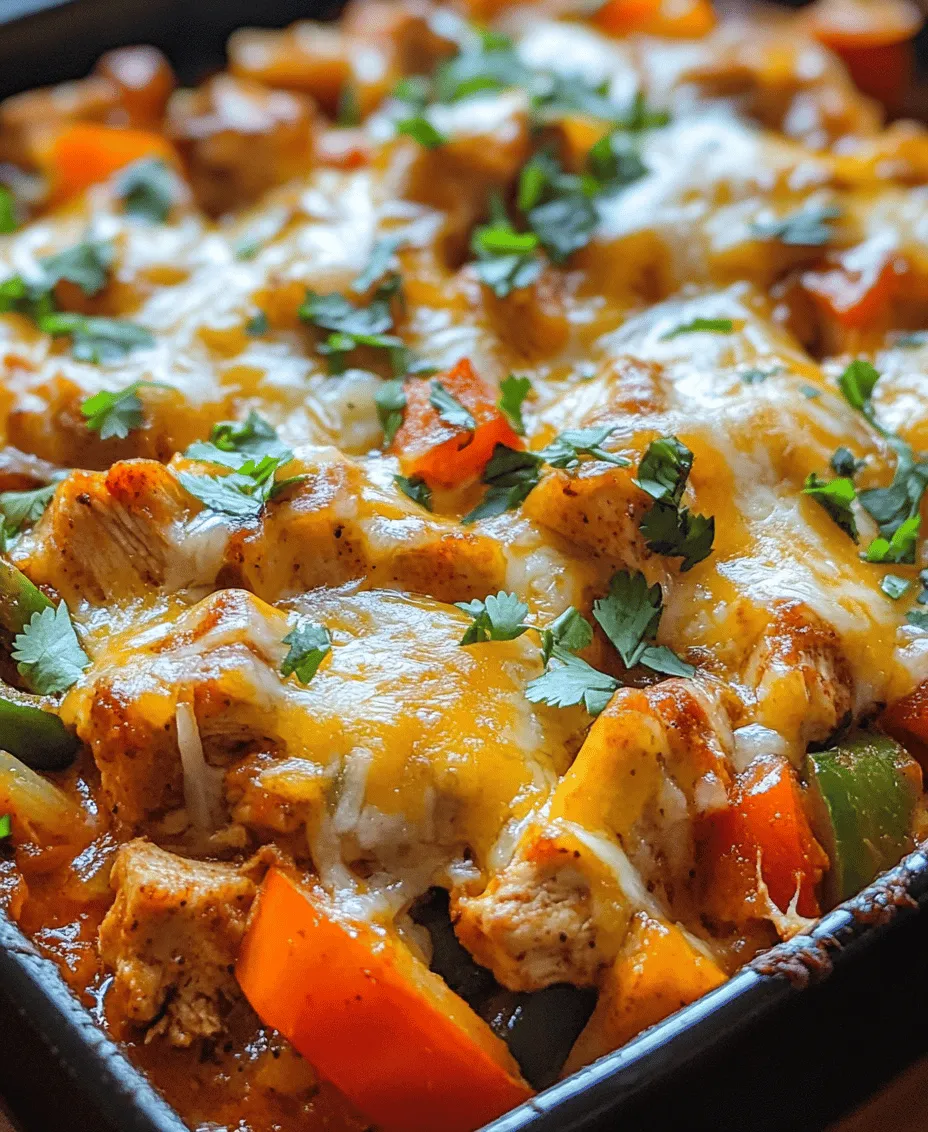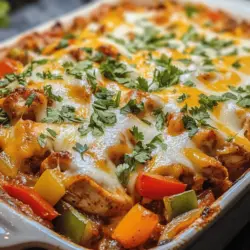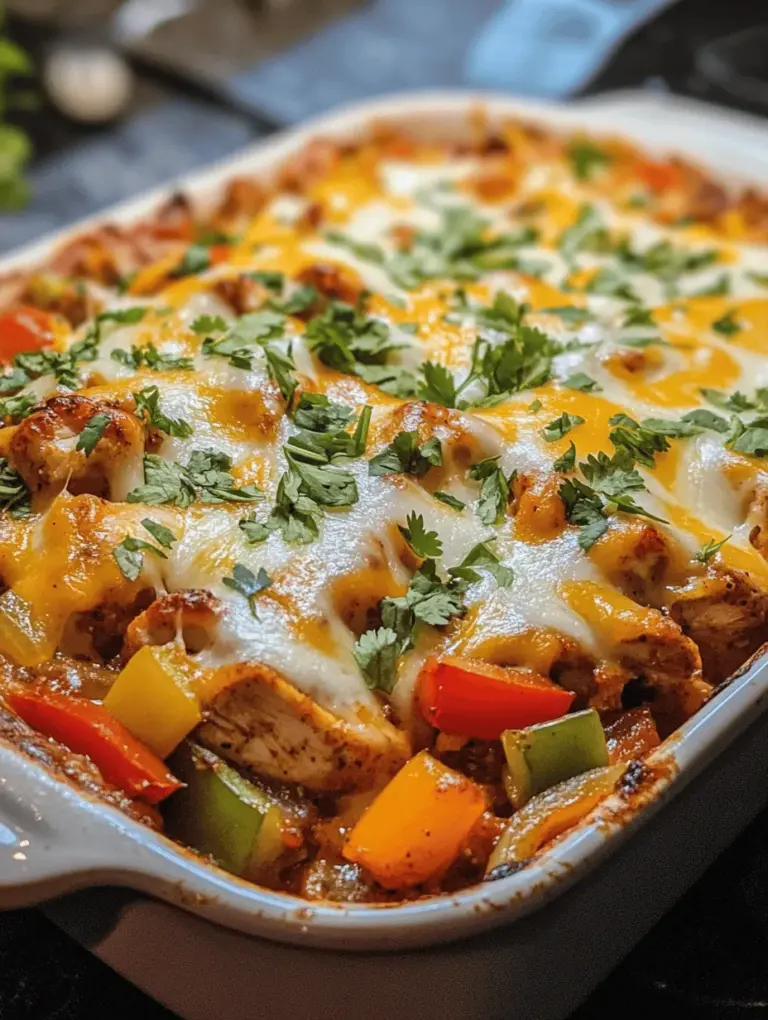Introduction
In the fast-paced world we live in, the allure of a one-dish meal cannot be overstated. Among the myriad options available, the Chicken Fajita Casserole stands out as a robust and flavorful choice that perfectly marries convenience with taste. This dish encapsulates the essence of traditional fajitas—succulent chicken, vibrant vegetables, and zesty spices—while offering the ease of a casserole format. Whether you’re navigating a busy weeknight or preparing for a family gathering, this casserole is an ideal solution that brings everyone together around the dining table.
The Chicken Fajita Casserole not only satisfies hunger but also invites a sense of comfort and warmth, making it a beloved option for many households. In this article, we will explore the various components of this dish, discussing the ingredients that contribute to its rich flavor profile, the preparation techniques that ensure a perfect outcome, and the cultural significance of fajitas, which have evolved from a simple street food into a family favorite in casserole form.
The Appeal of Casseroles
Casseroles as a Culinary Tradition
Casseroles have a long-standing history in home cooking, dating back to ancient civilizations where one-pot meals were a staple due to their simplicity and efficiency. The term “casserole” itself refers to both the dish used for cooking and the meal prepared within it. This culinary tradition has evolved over the years, adapting to changing tastes and ingredients while remaining a symbol of comfort food.
The versatility of casseroles is one of their most appealing aspects. They can be tailored to accommodate a wide range of dietary preferences and ingredient availability, making them suitable for any occasion. From hearty meat-packed dishes to vegetarian indulgences, the options are endless. Moreover, casseroles are perfect for feeding a crowd, allowing home cooks to prepare a meal that can easily be portioned and served.
Why Casseroles are Perfect for Feeding a Crowd
One of the primary reasons casseroles have remained a staple in many kitchens is their practicality. A single casserole dish can yield multiple servings, making it an economical choice for families or gatherings. Moreover, the ability to prepare the dish in advance means that home cooks can spend more time enjoying the company of their guests rather than being tied to the kitchen.
Additionally, casseroles often improve in flavor when allowed to sit for a while, as the ingredients meld together. This characteristic makes them perfect for potlucks, parties, or simply reheating for leftovers throughout the week. The Chicken Fajita Casserole, with its vibrant flavors and satisfying textures, exemplifies why casseroles have earned their place in the hearts (and stomachs) of many.
Ingredients Breakdown
Creating a Chicken Fajita Casserole begins with understanding the ingredients that come together to make this dish a standout. Each component plays a crucial role in building flavor, texture, and nutritional value. Let’s dive into the key ingredients that make this casserole a delightful meal.
The Star of the Dish: Chicken
At the heart of any Chicken Fajita Casserole is, of course, the chicken. For best results, it’s recommended to use boneless, skinless chicken breasts. This choice ensures that the chicken cooks evenly and remains juicy throughout the baking process. When selecting chicken, look for high-quality, fresh options—preferably organic or free-range—to enhance the overall flavor of the dish.
When preparing the chicken, consider the size of the pieces. Dicing or slicing the chicken into uniform pieces allows for even cooking and better integration with the other ingredients. This attention to detail in selecting and preparing the chicken is crucial for achieving a delicious final result.
Vegetables that Add Flavor and Color
The vibrant colors and flavors of onions and bell peppers are essential to the Chicken Fajita Casserole. These vegetables not only enhance the visual appeal of the dish but also contribute significantly to its taste profile. Onions provide a sweet and savory base, while bell peppers add a delightful crunch and a range of natural sweetness.
Incorporating fresh vegetables into your meals is also a great way to boost nutritional content. Bell peppers, for example, are rich in vitamins A and C, while onions have beneficial antioxidants. Together, they create a balanced and flavorful foundation for the casserole.
Spices and Seasonings
The key to elevating the flavor of the Chicken Fajita Casserole lies in the spices and seasonings used. Fajita seasoning is typically a blend of spices, including chili powder, cumin, garlic powder, onion powder, and paprika. Each of these elements plays a vital role in creating the signature fajita flavor that we all love.
When preparing this casserole, consider making your own fajita seasoning to customize the flavor to your liking. This not only gives you control over the ingredients but also allows you to adjust the spice level to suit your taste. A well-seasoned dish is essential for achieving a satisfying and memorable meal.
The Supporting Cast: Grains and Legumes
To create a complete meal, it’s essential to incorporate grains and legumes into your Chicken Fajita Casserole. Corn and black beans are excellent choices that add texture, nutrition, and a subtle sweetness to the dish. Corn provides a pop of color and a slight crunch, while black beans are a fantastic source of protein and fiber.
When selecting rice for the casserole, consider using long-grain varieties such as basmati or jasmine for a light and fluffy texture. Alternatively, brown rice offers a heartier option, packed with additional nutrients. Choosing the right type of grain not only enhances the dish’s texture but also contributes to its overall nutritional value.
Cheese: The Creamy Finishing Touch
No casserole is complete without a generous layer of cheese, and the Chicken Fajita Casserole is no exception. Cheddar cheese is a popular choice due to its sharp flavor and excellent melting properties. It creates a creamy, indulgent topping that brings the entire dish together.
For those with dietary restrictions or preferences, there are numerous alternatives available. Dairy-free cheese options made from nuts or soy can provide a similar creamy texture without the lactose. Additionally, if you’re looking to reduce calories, consider using a lighter cheese or simply reducing the amount used. Regardless of the choice, cheese adds a comforting finish that enhances the overall experience of the casserole.
Preparation Steps in Detail
Now that we’ve established the essential ingredients that come together to create the Chicken Fajita Casserole, it’s time to delve into the preparation steps. A well-organized kitchen and a clear plan can significantly improve your cooking experience and ensure a successful outcome.
Prepping Your Kitchen for Success
Before diving into the cooking process, it’s crucial to set up your kitchen for success. Begin by gathering all the necessary ingredients, tools, and equipment. This includes a large mixing bowl, a cutting board, sharp knives, and a baking dish. Having everything within reach will streamline the process and prevent unnecessary interruptions.
Additionally, preheating your oven to the appropriate temperature is essential before starting to cook. This ensures that your casserole bakes evenly and thoroughly once you combine all the ingredients.
Cooking the Chicken to Perfection
The first step in bringing the Chicken Fajita Casserole to life is cooking the chicken. Begin by heating a skillet over medium-high heat and adding a splash of oil. Once the oil is hot, add the diced chicken pieces, season with salt, and sauté until they are cooked through and golden brown. This process should take about 5 to 7 minutes, depending on the size of the chicken pieces.
To achieve the right level of doneness, use a meat thermometer to check the internal temperature, which should reach 165°F (75°C). Cooking the chicken to perfection is paramount, as it ensures that your casserole will be both safe to eat and delicious.
Sautéing Vegetables for Optimal Flavor
Once the chicken is cooked, remove it from the skillet and set it aside. In the same skillet, add a little more oil if necessary, and toss in the sliced onions and bell peppers. Sauté the vegetables over medium heat until they are tender and slightly caramelized, about 5 to 6 minutes. This step enhances their natural sweetness and brings out the robust flavors that will complement the chicken.
With the chicken and vegetables cooked to perfection, you’re now ready to assemble the Chicken Fajita Casserole. The combination of seasoned chicken, sautéed vegetables, and all the supporting ingredients will come together to create a dish that’s bound to impress. In the next section, we’ll explore the final assembly, baking process, and presentation tips to make your casserole a star at the dinner table.

Techniques for Cooking Vegetables Without Losing Nutrients
Cooking vegetables properly is crucial to retain their nutrients while enhancing their flavors. One of the best techniques is steaming, which allows the vegetables to cook through without submerging them in water, thus preventing nutrient loss. If steaming isn’t an option, sautéing with minimal oil over medium heat can also be effective. This method allows vegetables to soften while preserving their vitamins.
Another great practice is to use the microwave. Microwaving vegetables can be quicker and uses less water than boiling, which helps to keep nutrients intact. To maintain vibrant colors and crunch, always aim to cook your vegetables just until they are tender-crisp.
How to Know When Vegetables Are Perfectly Tender
Determining the right tenderness is essential for a delicious Chicken Fajita Casserole. Vegetables should be cooked enough to be soft but still have a slight bite. For bell peppers and onions, this usually means sautéing them for about 5-7 minutes until they begin to soften and become translucent. You can test the doneness by piercing them with a fork; they should yield slightly but not fall apart.
Mixing It All Together
Once your vegetables are cooked to perfection, it’s time to combine them with the chicken and spices.
Importance of Combining Ingredients Thoroughly
Thoroughly mixing the ingredients is crucial to ensure that every bite of the casserole is packed with flavor. This ensures that the seasoning is evenly distributed throughout the dish, allowing the spices to permeate the chicken, beans, and vegetables.
Tips for Ensuring Even Distribution of Flavors
When mixing, use a large bowl to combine the sautéed vegetables, cooked chicken, and any other ingredients like black beans or corn. Toss gently but thoroughly with a spatula to avoid breaking up the chicken too much. Taste the mixture before layering it into the casserole dish, and adjust the seasoning if needed.
Layering the Casserole
Best Practices for Layering Ingredients in the Dish
Layering is an art that contributes significantly to both the flavor and presentation of your casserole. Start with a base layer of the chicken and vegetable mixture, followed by a layer of shredded cheese. Repeat this process, finishing with a generous layer of cheese on top to create a bubbly, golden crust when baked.
How to Achieve an Aesthetically Pleasing Presentation
To achieve an aesthetically pleasing presentation, take care to spread each layer evenly across the casserole dish. You can also sprinkle some diced tomatoes or chopped cilantro on the top layer before baking for an added pop of color that enhances the visual appeal.
Baking to Achieve the Perfect Texture
Temperature and Timing for Optimal Results
Preheat your oven to 350°F (175°C) for baking the casserole. The typical baking time is around 25-30 minutes. This temperature allows the cheese to melt evenly while ensuring the casserole is heated through.
Knowing When the Casserole Is Done
The Chicken Fajita Casserole is done when the cheese is melted, bubbly, and slightly golden on top. You can also check if the casserole is warm in the center by inserting a knife. It should come out hot to the touch, indicating that the entire dish is ready to serve.
Serving Suggestions
Plating the Casserole
When it’s time to serve, use a sharp knife to cut the casserole into squares. This will help maintain the layers and prevent it from falling apart. Using a spatula, carefully lift each piece onto a plate, ensuring that it retains its shape.
Creative Ideas for Garnishing with Cilantro
A simple garnish can elevate the dish. Fresh cilantro adds a burst of color and freshness. Sprinkle chopped cilantro over the plated casserole right before serving. You can also add a dollop of sour cream or guacamole for an extra layer of flavor.
Pairing with Side Dishes
Recommendations for Complementary Side Dishes
To complement your Chicken Fajita Casserole, consider serving a fresh salad with lime vinaigrette, which can balance the richness of the dish. Mexican rice or quinoa can also make for a hearty side that enhances the meal experience. For a lighter option, grilled corn on the cob or a side of refried beans can beautifully round out the meal.
Beverage Pairings That Enhance the Meal Experience
When it comes to beverages, a chilled glass of margarita can be the perfect accompaniment. If you prefer non-alcoholic options, consider serving iced tea or a refreshing lime-infused sparkling water. These drinks can help cleanse the palate and enhance the flavors of the casserole.
Nutritional Information
Understanding the Nutritional Value
Each serving of Chicken Fajita Casserole typically contains approximately 350 calories, with around 25 grams of protein, 15 grams of fat, and 30 grams of carbohydrates. The dish is a balanced option, providing a good source of protein from the chicken and fiber from the vegetables and beans.
Health Benefits of the Ingredients Used
The ingredients in this casserole offer a range of health benefits. Bell peppers are rich in vitamins A and C, which support immune health. Chicken provides lean protein essential for muscle maintenance and repair. Additionally, beans are high in fiber, promoting digestive health. This combination makes Chicken Fajita Casserole a nutritious choice for any meal.
Cultural Significance of Fajitas
The Origins of Fajitas
Fajitas originated in the ranch lands of southern Texas in the 1930s. Initially, they were made from skirt steak, which was a lesser cut of meat, and were often cooked over an open flame. The term “fajita” comes from the Spanish word “faja,” meaning “belt,” referring to the cut of meat. Over the years, fajitas have evolved to include a variety of proteins and are now a staple in Mexican cuisine.
Evolution of Fajitas into Modern American Cuisine
The popularity of fajitas surged in the 1980s when they became a favorite in Tex-Mex restaurants across the United States. Today, they are often made with chicken, shrimp, or even vegetables, showcasing the adaptability of this beloved dish. The Chicken Fajita Casserole is a modern twist that combines traditional flavors with the convenience of a one-dish meal.
Fajitas in Popular Culture
The Popularity of Fajitas in Restaurants and Home Cooking
Fajitas have made their mark in American food culture, becoming a popular menu item in many restaurants. Their interactive nature—often served sizzling on a hot plate—makes them a fun dining experience. Home cooks have embraced fajitas for family dinners, and the versatility allows for endless variations based on personal preferences.
How Casseroles Have Adapted This Beloved Dish for Convenience
Casseroles have become a go-to for busy families, and adapting the fajita concept into a casserole makes the dish even more accessible. This method allows for a make-ahead option, perfect for meal prepping or feeding a crowd without the hassle of individual servings.
Conclusion
The Chicken Fajita Casserole stands out as a delightful fusion of flavors and textures, embodying the essence of comfort food while allowing for flexibility and creativity in the kitchen. With its balance of protein, vegetables, and cheese, this casserole is not only satisfying but also a great way to bring families together at the dinner table. Whether for a busy weeknight or a weekend gathering, this dish is sure to become a favorite in your household. Enjoy the rich, bold flavors of this casserole, and don’t hesitate to make it your own by experimenting with different ingredients and garnishes.


